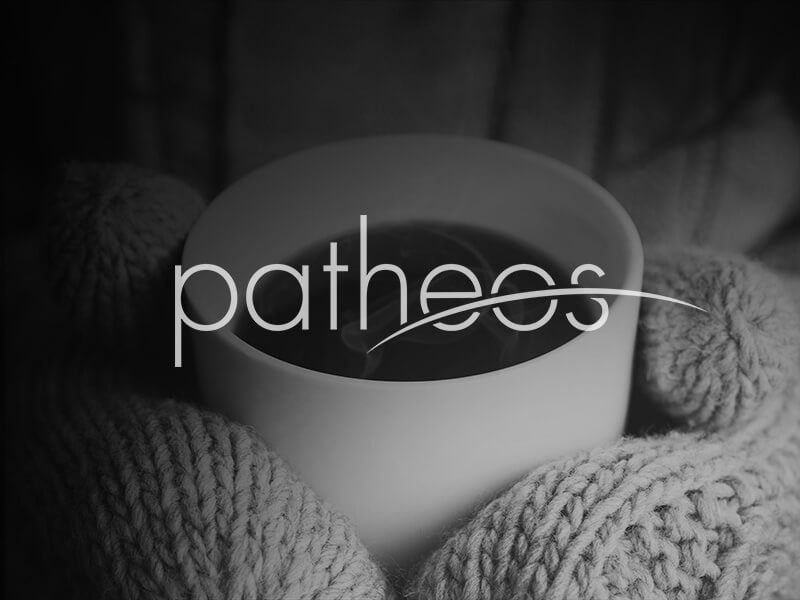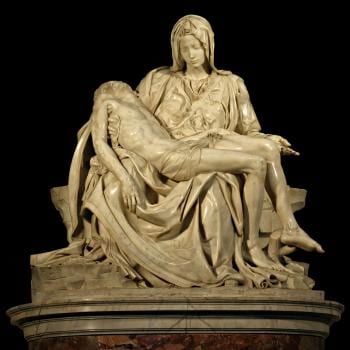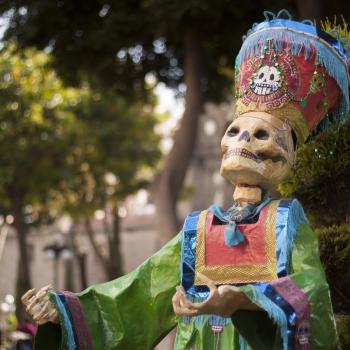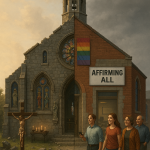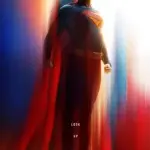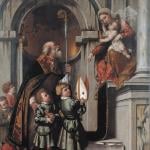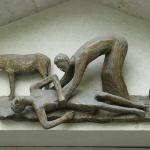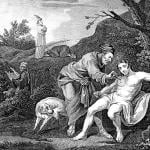How are we to interpret the famous passage from Revelation 12 which is read at Mass for this Solemnity of the Assumption of the Blessed Virgin Mary into heaven?
Then God’s temple in heaven was opened, and within his temple was seen the ark of his covenant. And there came flashes of lightning, rumblings, peals of thunder, an earthquake and a severe hailstorm. A great sign appeared in heaven: a woman clothed with the sun, with the moon under her feet and a crown of twelve stars on her head. She was pregnant and cried out in pain as she was about to give birth. Then another sign appeared in heaven: an enormous red dragon with seven heads and ten horns and seven crowns on its heads. Its tail swept a third of the stars out of the sky and flung them to the earth. The dragon stood in front of the woman who was about to give birth, so that it might devour her child the moment he was born. She gave birth to a son, a male child, who “will rule all the nations with an iron scepter.” And her child was snatched up to God and to his throne. The woman fled into the wilderness to a place prepared for her by God, where she might be taken care of for 1,260 days.
The language of the Book of Revelation is mystical. It’s dream language. Therefore, as in our own dreams, the things we see are symbolic. Time is suspended. ‘Real’ things and people are conflated with deeper meanings and the ‘real’ things become symbolic and the symbols become ‘real’. So does the passage mean?
God’s temple in heaven is opened, and we are given a little glimpse of heaven itself. The dramatic stormy imagery evokes the scenes on Mount Horeb where Moses received the Ten Commandments and where Elijah heard the ‘still, small voice’. There, in the midst of the temple is the Ark of the Covenant. The Ark of the Covenant is the throne of God. It is the golden box that held the Tablets of the Law and the Manna in the Wilderness. The Ark of the Covenant–according to the Fathers of the Church–is also the Blessed Virgin–the pure vessel that bore the Word of God and the Bread of Life.
The great sign that appears in heaven is a woman clothed in the sun. Just as it does in dream language, one symbol shifts into another. It fulfills the earlier symbol and opens up a new meaning. The ark of the covenant is a woman clothed in the sun, with the moon under her feet and a crown of twelve stars. What is the sun? Later in Revelation, we’re told that in heaven there is no sun or moon or stars for the Lamb is the Light in the City of God. The woman therefore is clothed in the Light of the Lamb. Standing on the Moon she is identified with the Moon itself–which reflects the light of the sun as she reflects the Light of the Lamb who is her Son. She wears a crown of twelve stars for she fulfills the promise of the nation of Israel with twelve tribes as well as the promise of the Apostolic Church–which with twelve apostles–is the new Israel. As such the woman holds in herself the People of God–both the nation of Israel and the Church. She is at once Sarah–the Mother of Israel and Mary the Mother of the Church.
The Mother is pregnant and about to give birth and cries out in pain. Some people have asked why Mary cries out in pain when the traditions about the Virgin Birth say that she gave birth without pain since pain in childbirth is a consequence of the Fall and she was free from original sin. This is to take the Revelation passage too literally. The woman is Mary, and the child is Jesus Christ, but as in all dream language, each thing carries more than one meaning. Now, caught up in the cosmic struggle, the great Mother also stands for all of creation which St Paul tells us “is groaning as in childbirth for it’s redemption.” These are the “birth pangs of the new age” They are also the birth pangs of the new age brought about by the passion of her son. His death and resurrection was a kind of death and re-birth and so her agony is a sign of her seven sorrows as a sword pierces her own heart and she identifies with the mystery of pain and suffering–the battle against Satan and the great birth that will be the consequence.
The great red dragon represents the earthly powers as well as Satan. From the beginning the woman was tempted by the serpent, and it was prophesied that she would trample his head. Here time is suspended and the battle in Eden and the last cosmic battle are one. The seven heads with seven crowns simply represent the perfection and completion of earthly power. Seven is the symbol of perfection and completion in the ancient world, and for the beast to have seven heads with seven crowns symbolized earthly power at it’s zenith. The number ten represents the cosmos–the physical creation, and the red color symbolizes passion, fire, blood, violence and fury. So the red dragon is a pure symbol of earthly, cosmic power expressed in violence and rage. His tail sweeping the stars out of the sky to earth is a sign of the fall of the angels. The stars are symbols of heavenly spirits who were swept out of their place in heaven under the influence of the Prince of Darkness.
The Beast wishes to devour the child who is one who will rule with a scepter or iron. This is a direct reference to Christ the King in Psalm 2:9 who will rule the nations with an iron scepter. Again, time is conflated and now we are at the birth of Christ where earthly kings like Herod were eager to destroy the child from the time of his birth. The child is snatched up to heaven–referencing Christ’s resurrection and ascension, while the woman flees to the wilderness.
Now the woman is the persecuted church. Remember that the Book of Revelation is written during a time of persecution, and the woman in the wilderness is the symbol of the church of God hiding from the persecuting powers–for now the Red Dragon is the Roman Empire–the earthly power persecuting the Church. The ‘1260 days’ is not to be taken literally, nor should any attempt be made to do ‘Biblical fortunetelling’ with such numbers. The number 1260 symbolizes the fullness of time or ‘when the time is right’. As such it is a sign that the church will remain in the wilderness of persecution protected from the beast by God until the fullness of time comes for her to be freed.
So should Revelation 12 be read as a ‘proof text’ for the Assumption of the Blessed Virgin into heaven? Yes and no. ‘No’ if by ‘proof text’ this provides a historical account of her assumption like the accounts we have of Christ’s ascension. However, ‘Yes’ if we mean that Mary’s place in the cosmic plan of redemption is completed, and her Assumption–a place of exaltation in the heavenly realm– is pictured. Her role in the cosmic battle against Satan is shown as is her role as Mother of the Church. All of this is gathered up in the passage from Revelation and made explicit in the Dogma of the Assumption–which completes Marian doctrine as it fulfills the prophecy from Genesis that she would trample down the old serpent under her feet.



